Sandwiched between Czech Republic and Hungary, my trip to Slovakia last year was brief. I’d been there for a longer stay a dozen or so years ago, but have few good pictures to prove it (back then, I was shooting with this). This time, I visited only Bratislava, so we’ll have a look at Slovak gastronomy through the prism of the capital city’s restaurants.
If a picture is worth a thousand words, the photo menu at restaurant Segnerova Kúria in the old town is the perfect crash course in traditional Slovak cuisine (click on the image to enlarge). Basically, take any combination of potato, cabbage, pork, and bryndza, and fill the plate until food starts falling off the edge. Create some additional extra large portions to flatter the diner’s ego (e.g., “a king’s feast with four kinds of meat”, or “Slovak pride – four Slovak dishes served on a single plate”). Warning: I have not in fact eaten at Segnerova Kúria, and most TripAdvisor users who have don’t recommend it — it’s ranked #732 of about 850 reviewed restaurants in Bratislava, which isn’t glorious.
Now, if you’d rather try haute Slovak cuisine, there’s the UFO restaurant at the top of the pylon on the Bridge of the Slovak National Uprising, aka SNP Bridge. No, this isn’t just a pun (haute cuisine, get it?!) — the new chef really put together a pretty ambitious menu! In his dégustation de la maison, local ingredients are given a modern twist (think bryndza ice cream, beet jelly, or rye crumble), and then there’s a mish-mash of equally ambitious but very random dishes with influences spanning Croatia, India, Thailand, China, Japan, and Australia. I haven’t eaten there either (I only visited the observation deck), and reviews on TripAdvisor are mixed, but many claim that the food is very good.
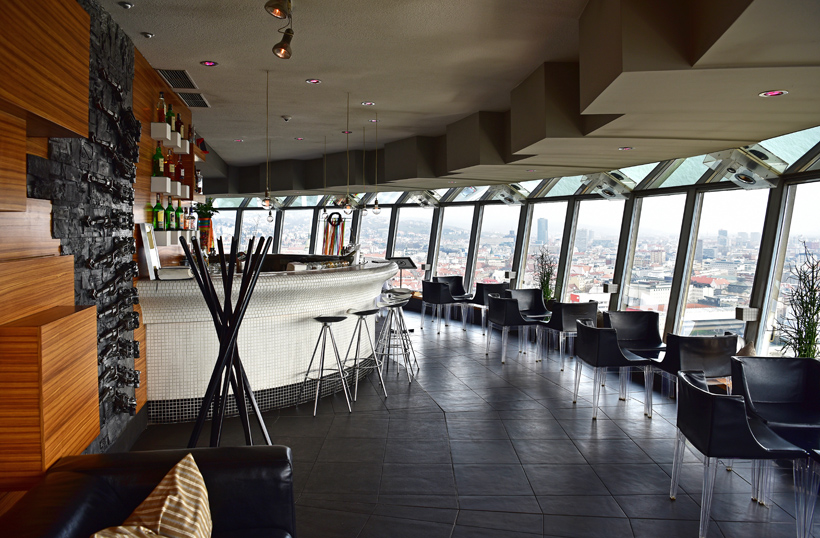
But now let’s talk about the places I’ve actually tried firsthand…
Just like neighboring Czech Republic, Slovakia is a country of pubs, so it makes sense to start with Bratislavský Meštiansky Pivovar, a restaurant cum brewery that’s handily resurrected one of the oldest names in Slovak beer brewing. Beer in Slovakia has been produced at least since the 15th century, but none of the earlier breweries have survived. In 1752, near the Danube in Bratislava (then capital of the Kingdom of Hungary), was built Die Bürgerliche Brauerei, translated as “Burgher’s Brewery” in English, or Meštiansky Pivovar in Slovak. The place quickly became known not only for the quality of its beer, but also for its food. It doubled up as a “restaurant with a quality cuisine” where “all the culinary wonders of almost each of the ten nationalities represented in the city were served”. Then, after about 200 years, came communism. The establishment was demolished in 1968 to make room for the majestic SNP Bridge (the one with the UFO; see above). “It was not meant to please beer lovers any longer”… Until 2010, when a new generation re-started Meštiansky Pivovar as a micro-brewery, a little bit further north of the river. The website proclaims that “where nice beer is brewed […] there must a be good cuisine”, and the kitchen tries to offer a menu that blends tradition and seasonality.
The resulting menu is quite large, with over 60 items. It all sounds great, but after a while, it provokes a feeling of déjà vu. Without going through all the sections, let’s take a look at the beer snacks: utopenec (pickled sausage with chili peppers, spring onion, and garlic); aspic with pork knuckle, onion, and vinegar; smoked headcheese with vinegar and onion; cheese and charcuterie platters; steak tartare. And, this being Slovakia, there’s a special section for lovers of all things potato: the inevitable bryndzové halušky, of course; Liptovské strapačky (which don’t look all that different from halušky) with sauerkraut and bacon; pierogi-like pirohy; potato dumplings (of the knedlík variety) with smoked meat, stewed sauerkraut, sour cream, and roasted onion; fried cheese with fries and tartar sauce… All light stuff.
The bryndzové halušky with bacon are the national dish, and I’ve posted my own recipe here. At Meštiansky Pivovar the halušky themselves are more or less typical spaetzle, very airy and not at all the big doughy blobs for which some recipes advocate. The bryndza sauce is pretty liquid, with little chunks of cheese in it, and the dish is topped with fried diced bacon and chopped chives. I added a little bit of paprika (which was in a shaker on the table). Very good.
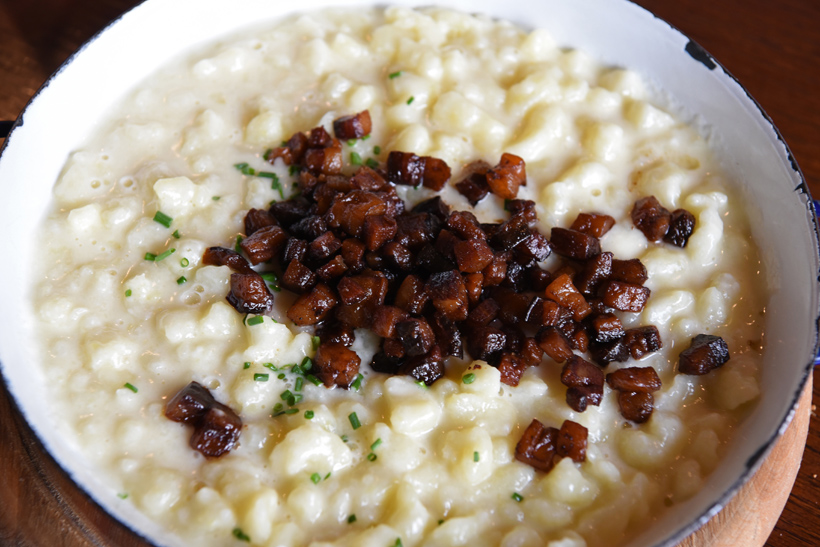
The pirohy with bryndza, bacon, onion, and sour cream are potato dumplings, a bit like boiled Ukrainian varenyky or Polish pierogi. The potato dough is quite thick but very soft at the same time, so it’s not unpleasant. It’s filled with salty brynza mixed with mashed potatoes and a bit of chives, and topped with sour cream, more chives, very crispy fried onions, and fried bacon dice. Just like the halušky, this is a well-executed rustic dish that relies on the contrast between the soft-textured and flavor-absorbing potato, the salty bryndza and bacon, and the crispy toppings.
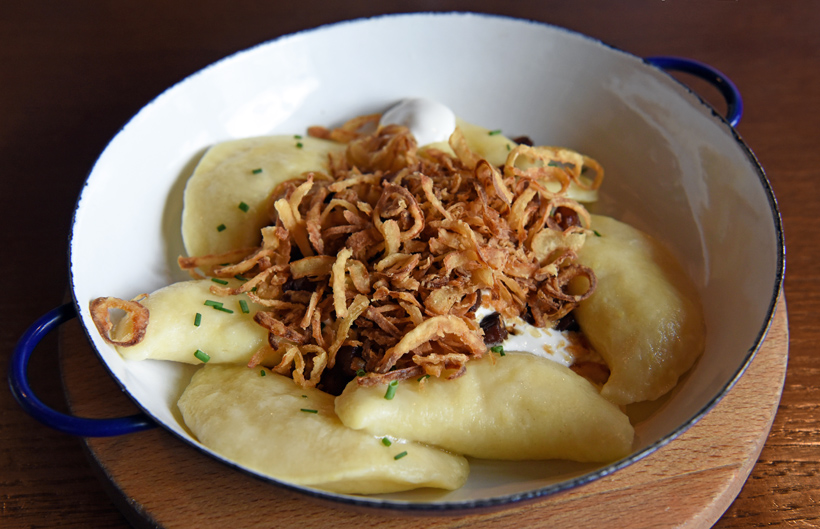
There’s even fried onion and bacon in the bread that the waiter brings to the table! Not that any of those dishes really calls for bread, mind you. But maybe the homemade sausage with mustard and horseradish does. The sausage is very smoky and spicy, a bit greasy (as it should be). The meat inside, which is probably pork, is rather coarsely ground, with chunks still visible. It’s served with mild, sweet mustard and grated fresh horseradish.
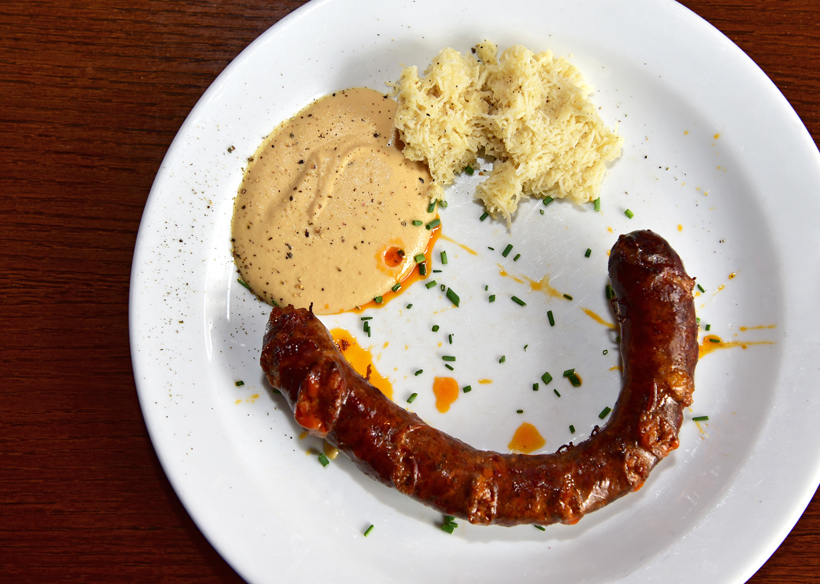
Our next stop is Modrá Hviezda, a restaurant that certainly sees a lot more tourists than it does locals. I remember going there for the first time back in 2003! As far as I can tell, the interior hasn’t change much: it’s still a mix of “many original period features,” as the website says. One room has a vaulted ceiling, another looks like a country house. The tiles on the floor are carved with pictures of knights and medieval feasts. All this in a building dating from the 18th century! The restaurant is located more or less under the walls of the Bratislava Castle, in a neighborhood called Podhradie (which means… “under the castle”). This part of town went through tumultuous episodes in the past hundred years. It fell into disrepair and abandon in the first half of the 20th century, and was then largely destroyed to build the SNP bridge and the large four-lane roadway that leads to it. The latter effectively isolates the castle from the old town. Cars speed along less than four meters from the façade of St Martin’s Cathedral — one of the communists’ ways of giving the finger to the symbols of the past. You can read more about the history of Podhradie here.
The menu at Modrá Hviezda is traditional Slovak, maybe less rustic than at Meštiansky Pivovar, though that could just be due to what we chose to order. It’s definitely shorter, so I’m going to take you through the oft-tedious list of dishes that drew my attention. In the appetizers: smoked trout with sweet pea and dill dressing; beef tongue with apple-horseradish sauce and toast; sautéed foie gras with onion marmalade; beets stuffed with farmer cheese. In the entrées: lamb shank on root vegetables with potato strudel (zemiaková štrúdľa in Slovak); pork roast with chestnuts and pumpkin purée; wild boar loin with parsnip purée; venison goulash with bread dumplings; rolls of baked trout wrapped in leek with mashed potatoes; zucchini pancakes; and yes, bryndzové halušky. Given the number of beef steaks I’ve seen on menus in Central Europe, it’s also time I start keeping track of all the different preparations so I can eventually post my own recipe. I have very few beef steak recipes on my blog (there’s the Roumanian steak that’s not really a steak, and several recipes for venison like this one or that one, but no real beef steak). So for the record, Modrá Hviezda has no less than three options: steak with wild mushrooms (porcini, it seems) and potato dumplings (zemiakové šúľance); steak with herb butter and green beans wrapped in bacon; and steak with green peppercorns and roasted potatoes. Meštiansky Pivovar had several steaks too, but they weren’t particularly noteworthy compared to these. The desserts at Modrá Hviezda are quite interesting too: Slovaks love potatoes so much that they even use them in sweet dishes. Those potato dumplings served with steak? Sprinkle them with a mix of sugar and ground walnut or poppyseeds, and voila! You’ve got yourself a dessert. And if varenyky can be a dessert, the same holds true for potato pirohy — just fill them with fruit preserves!
No appetizers this time, as there are only so many such hearty dishes one can eat in a day. We’re starting straight away on the rabbit in paprika sauce with halušky. The rabbit leg is very tender and more flavorful than the farmed rabbits you find in the U.S.A. The halušky are a little bit dense, and bigger than typical spaetzle this time — still, they’re almost like spaetzle. The sauce doesn’t taste a lot like paprika, and reminds me of a cross between a stew and a goulash, with sour cream.

The venison medallion with sour plum sauce and mashed potatoes was listed as the chef’s one and only specialty. The meat boasts a great gamey taste. It’s pretty tender for something cooked medium-well, but it would be even better if it arrived cooked to my actual choice of doneness. The sauce is a bit sour and not overly sweet, and given the season I assume that the plums are prunes. The generous serving of rich, flavorful, and slightly dense mashed potatoes makes me wonder yet again what people ate in Slovakia before America was discovered. But overall, this is an enjoyable dish, just like the rabbit.
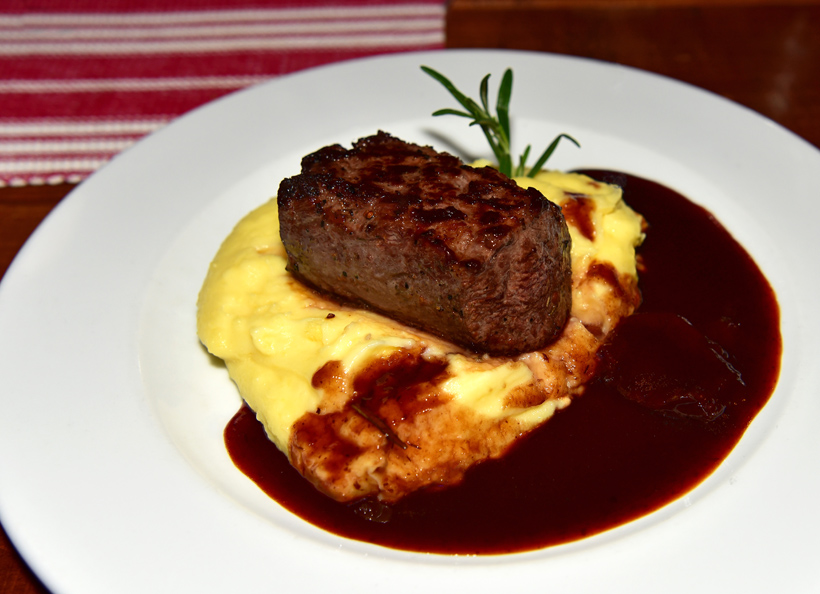
Now the time has come to try a potato dessert. The perky with plum preserves and poppy seeds look just like large pirohy, filled with a little bit of preserves, topped with melted butter, and sprinkled with a mix of poppy seeds and confectioners’ sugar. The potato dumplings are like very thick ravioli, heavy but still very soft, not doughy at all (again, just like pirohy). It’s almost like eating sweet polenta or sweet mashed potatoes for dessert. There’s so little of the plum preserves that I can taste the poppy seeds a lot more than the plum. Not bad, but two perky are more than enough, since they’re very, very rich. And they’re a bit of an acquired taste.
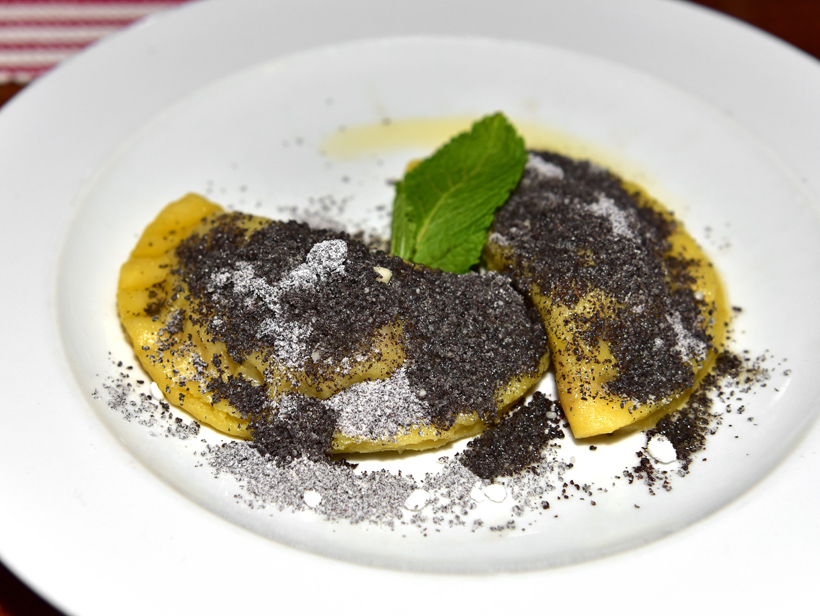
I’ve read that this restaurant makes its own wine, but I didn’t get to try it. Instead, I tasted the Pavelka Alibernet 2013, a pleasant but simple red with a nose of berries and hints of violet. Alibernet is a crossing of Alicante Bouschet and Cabernet Sauvignon that was bred in 1950 by the Ukrainian Scientific Research Institute for Wine and Vines in Odessa, and is now cultivated mostly in Czech Republic and Slovakia.
I finished the meal with a glass of 52% malinovica, a rather strong raspberry brandy with crisp berry flavor that’s on par with similar good brandies from other parts of the world, most of them between Paris and Bucharest.
Finally, Kontakt, our third restaurant, is a much more recent establishment, opened in 2013. It’s located in the old town, but doesn’t feature any century-spanning history that I know of. I love their motto, though: “Food from our grandmas, served in 21st century style”.
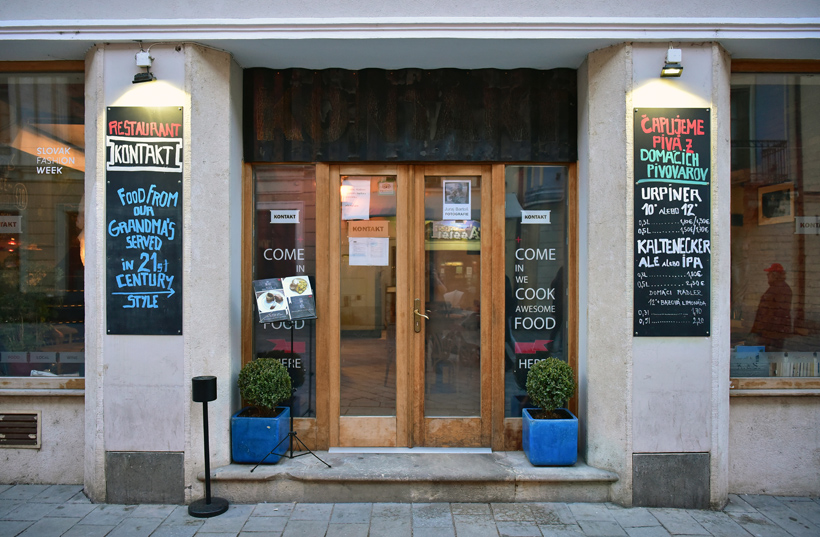
The menu is very short and changes daily. It’s generally Slovak, but sometimes explores other cuisines. On the day of our visit, in addition to what we tried, I spotted: beetroot tartare with horseradish aioli and toast; chickpea patty and beet carpaccio with pumpkin purée. And to continue the steak series: hanger steak with celery salt, honey-parsnip purée, nut sauce, and celery salad. I know it may sound funny after describing the steak, but this is definitely a vegetarian-friendly restaurant, too.
The terrine of pork knuckle and root vegetables, marinated onion, and parsnip chips is a modern rendition of the pork in aspic that appears on many menus (including Meštiansky Pivovar above) — just look for huspenina. The pork knuckle is very tender. You don’t see it in my picture below, however, because it’s covered with a brunoise of carrot and another vegetable I didn’t identify. The whole thing is set in aspic, though if you ask me, a modern pork in aspic should probably ditch the aspic altogether. The fried parsnip chips and pickled onion (which I first mistook for fennel) provide good texture and taste contrast.
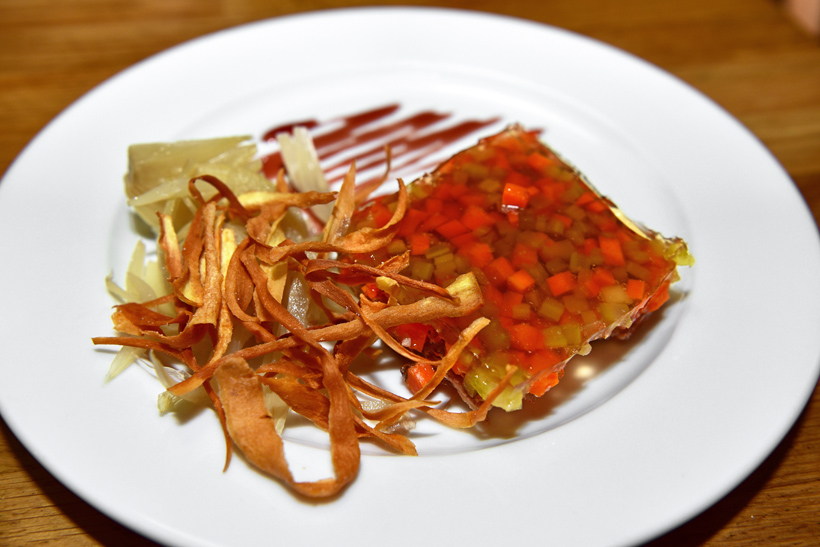
The sauerkraut soup comes either with pork and potato dumplings or in a vegetarian version. The vegetarian version features dried mushrooms, prunes, potatoes, sour cream, and lovage. It’s simple but good, maybe with slightly too much sauerkraut. Granted, the dish is called sauerkraut soup…
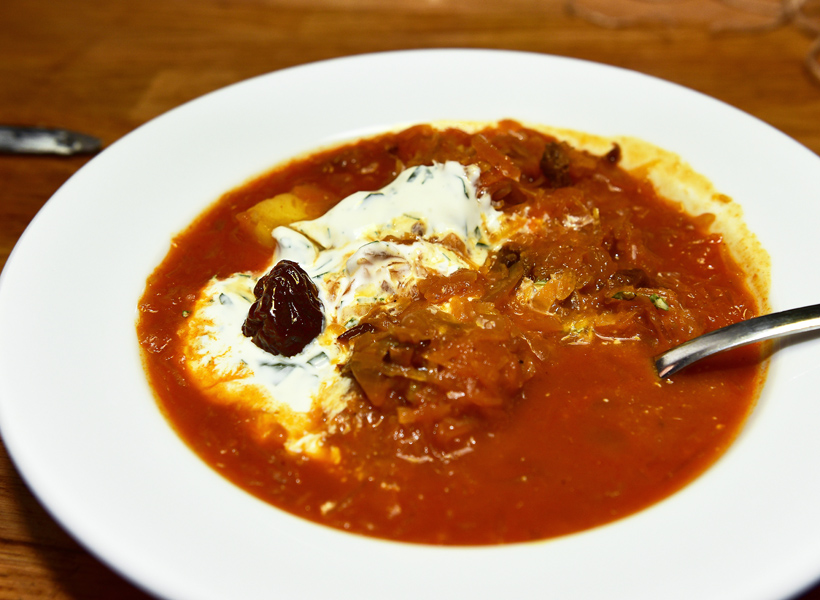
The beef stew with red wine and root vegetables is a pretty typical stew prepared with beef, carrots, parsley root, and red wine, topped with thinly sliced scallions. There’s a side of grilled zucchini, but I’m not sure this is enough to conclude that green squash is a fixture of the Slovak table.
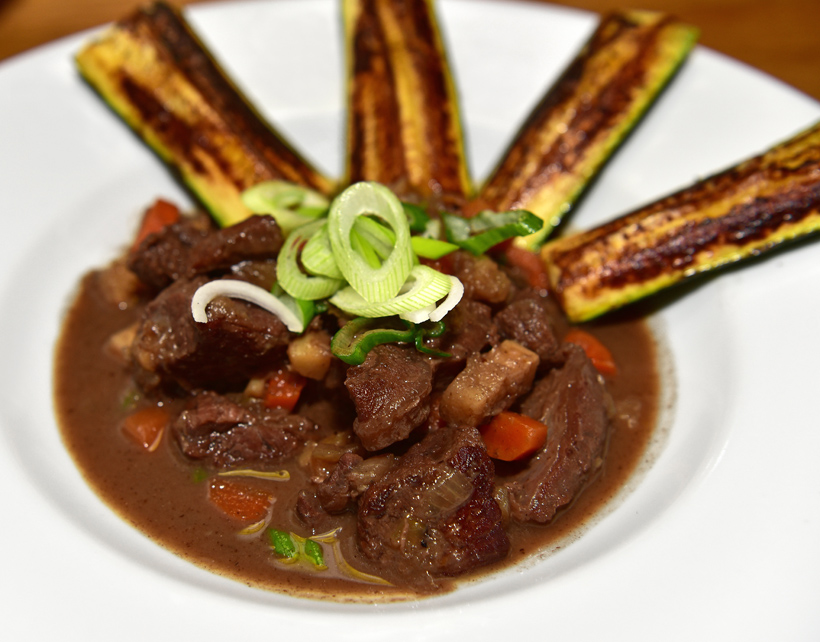
For dessert, the pancakes with vanilla curd cheese and blueberry sauce look nicer than most pancake plates I’ve seen. The pancakes are thick and fluffy, The vanilla curd cheese tastes tangy. The blueberries are, well, blueberries…
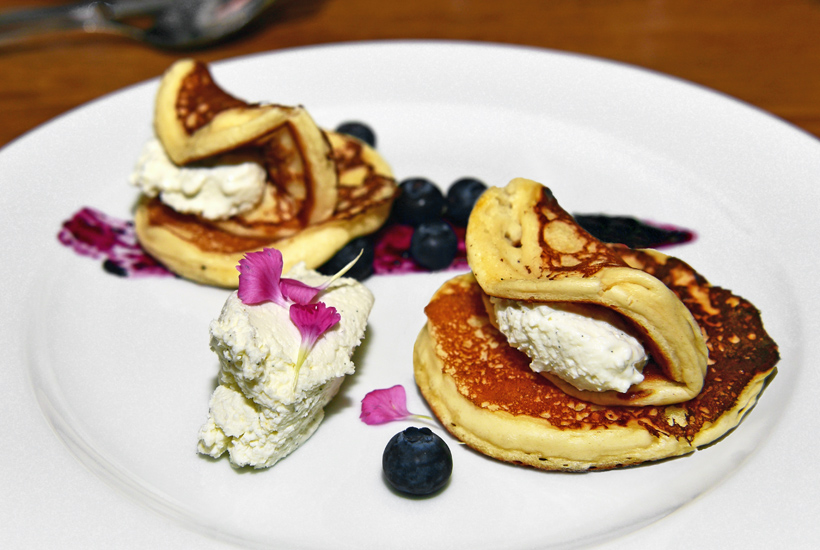
Wow, a whole meal without potatoes! We couldn’t avoid the pork and sauerkraut, but this is still an achievement. Oh wait, no… There were potatoes in the soup! I guess you really can’t run away from them in Slovakia.
Anyway, this is all I have to say about Slovak cuisine at the moment. Next time, we’ll cross the southern border to visit Hungary!

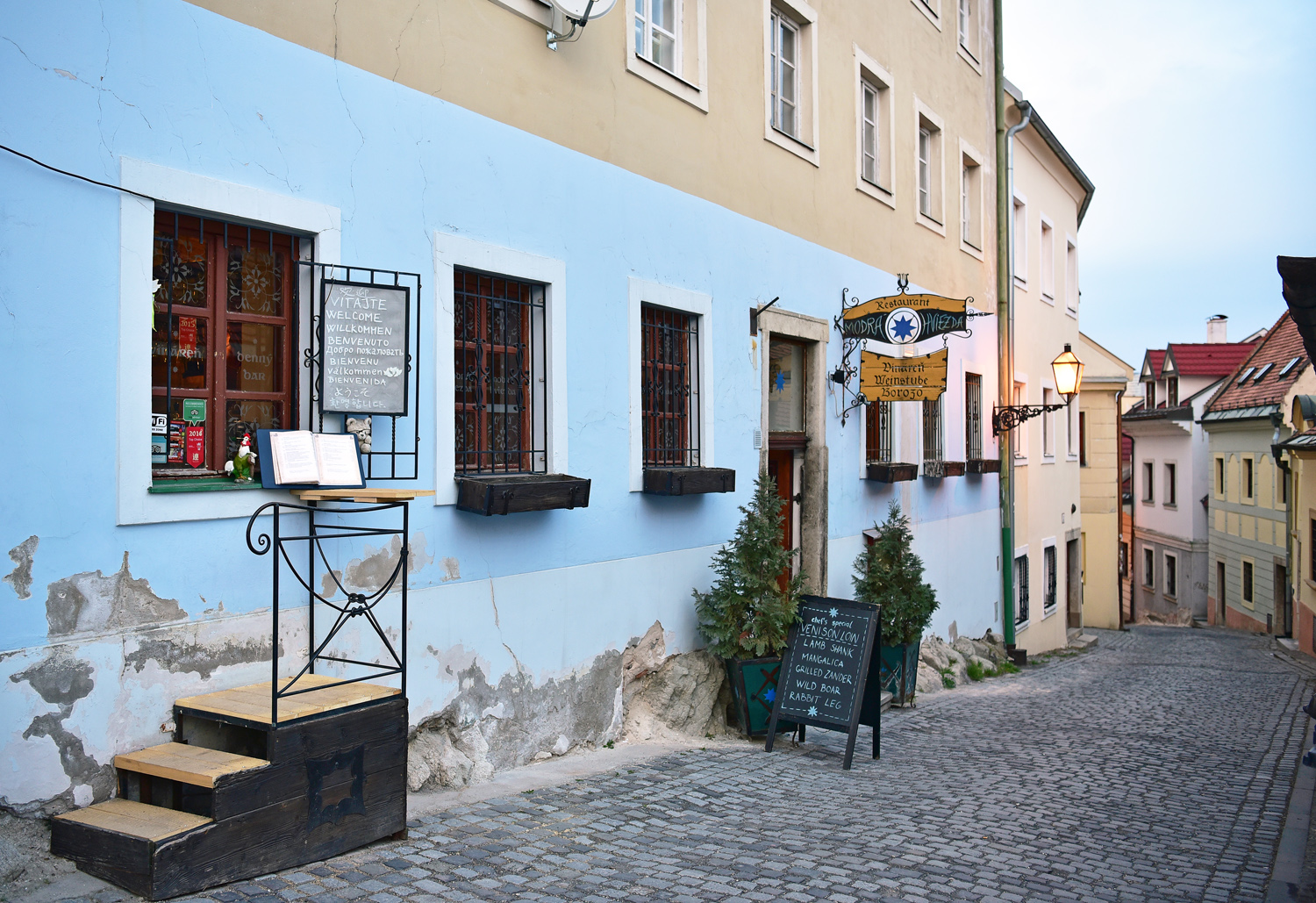
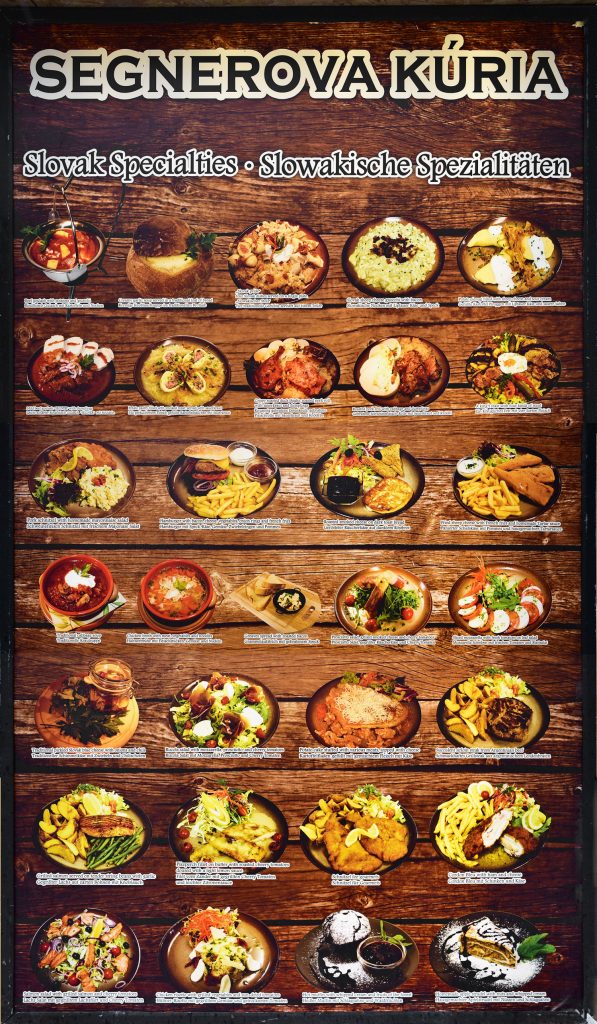
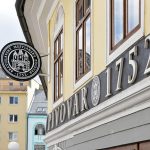

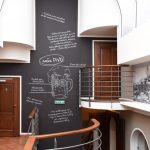

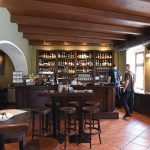

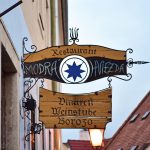
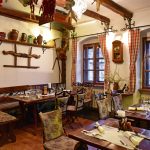





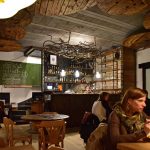
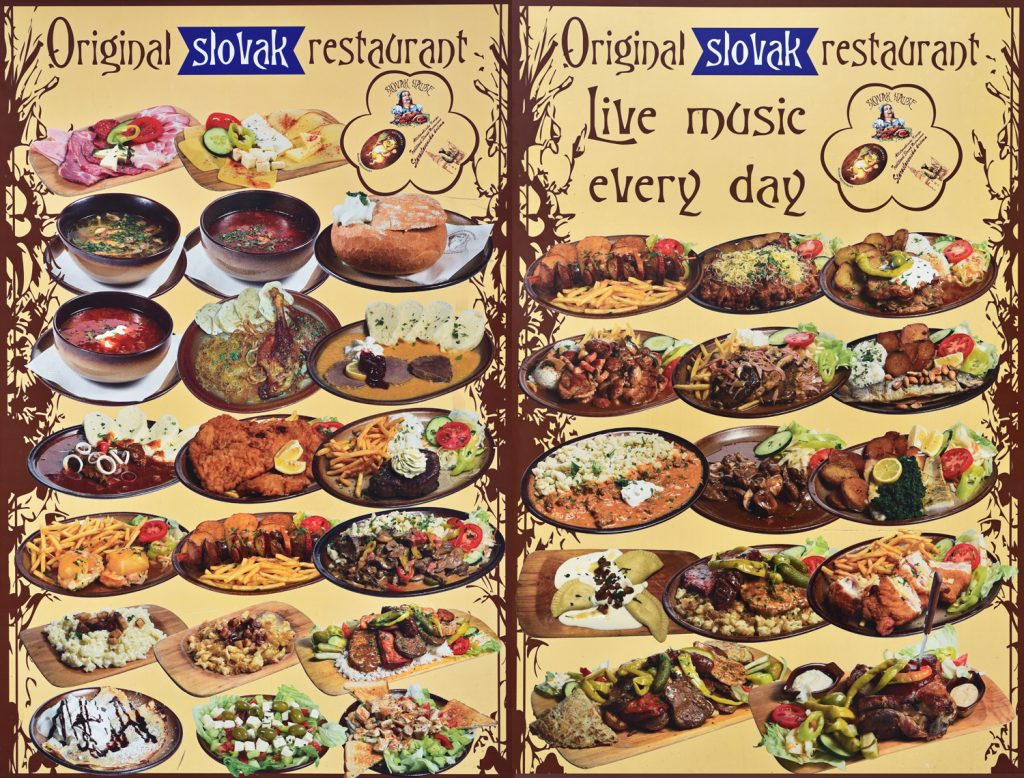
2 comments
Your blog is fantastic! I lived in the Czech Republic for 2 years and have been to Georgia once. Everything I read here is so inspiring and appetizing and funny and insightful and just… interesting. Thank you!
Thanks a lot, Chris!